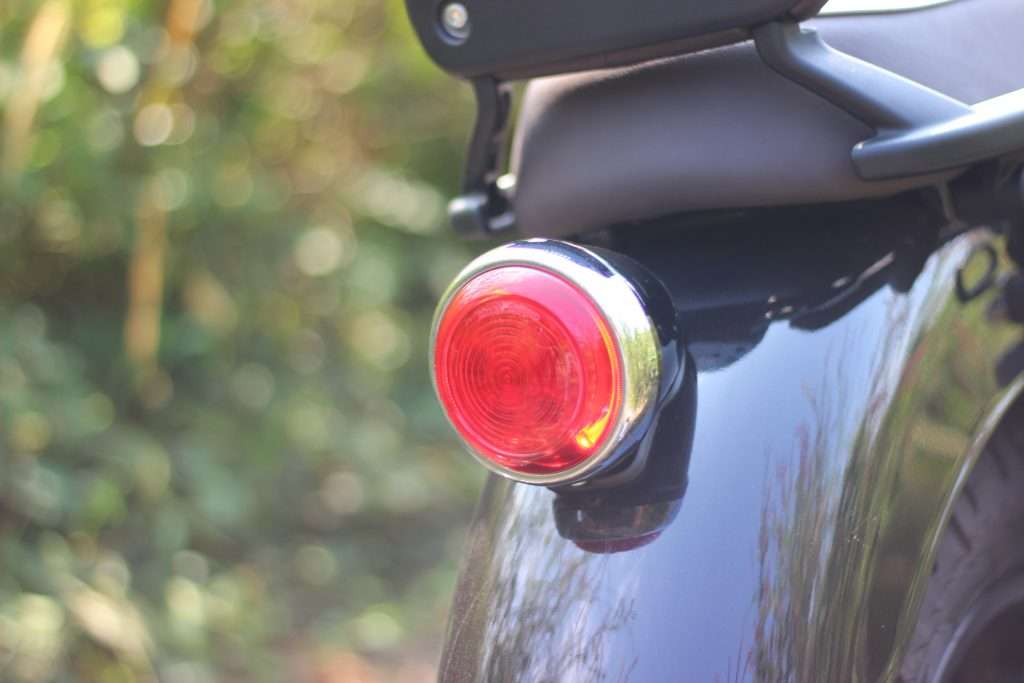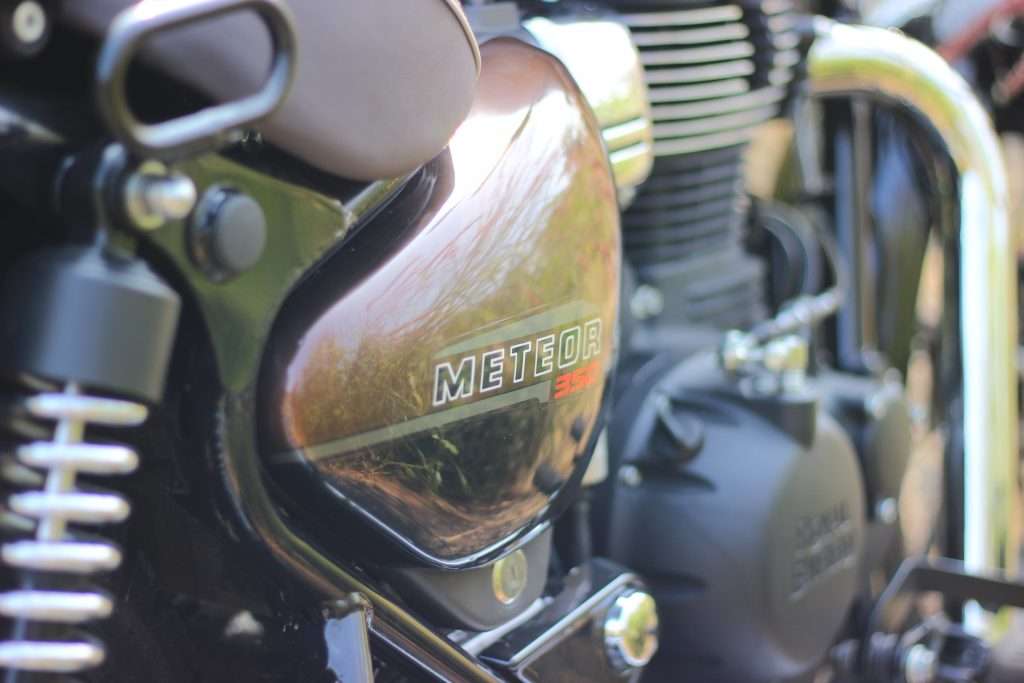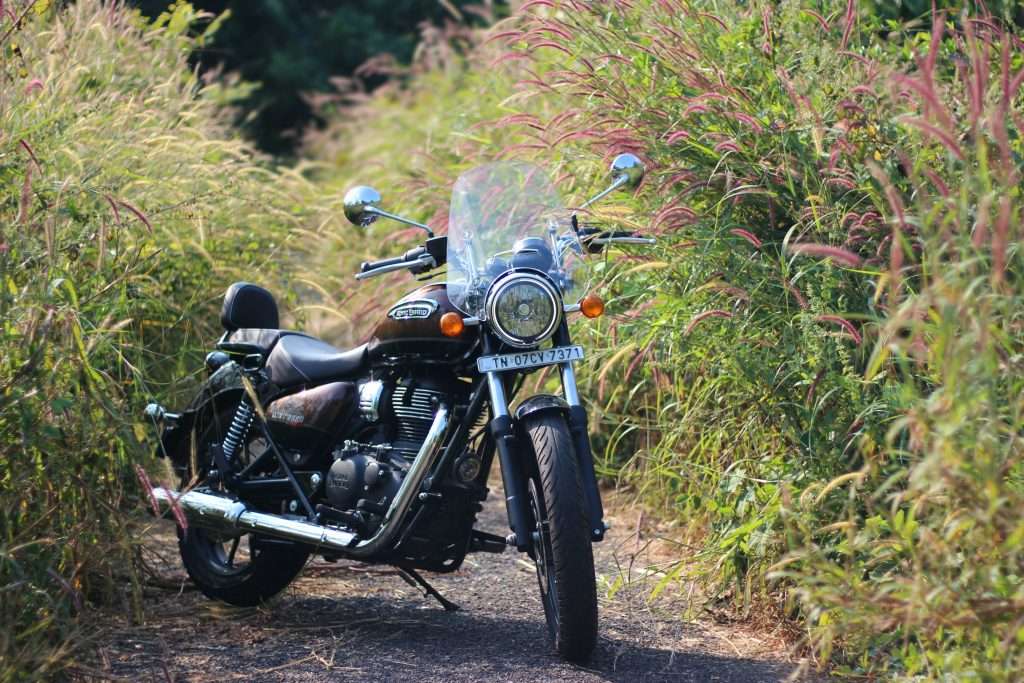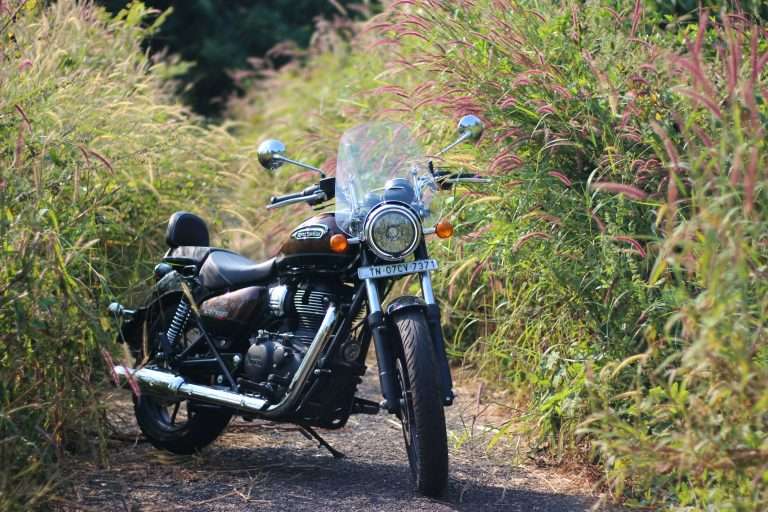I lived with the all-new Royal Enfield Meteor 350 for four days and munched 500+ miles with it. Here’s what I have to say…
Royal Enfield Meteor 350 : Tracing The History
The Royal Enfield Meteor 350 comes in as a technically advanced replacement for the Thunderbird range. The Royal Enfield Thunderbird needs no introduction in the Indian context. It was a motorcycle that spearheaded the mid-size cruiser bike segment in the country. The first-gen TB had come in as a replacement for the Royal Enfield Lightning, in 2002. The Thunderbird range attained what I would call a ‘minuscule’ success in its first generation.
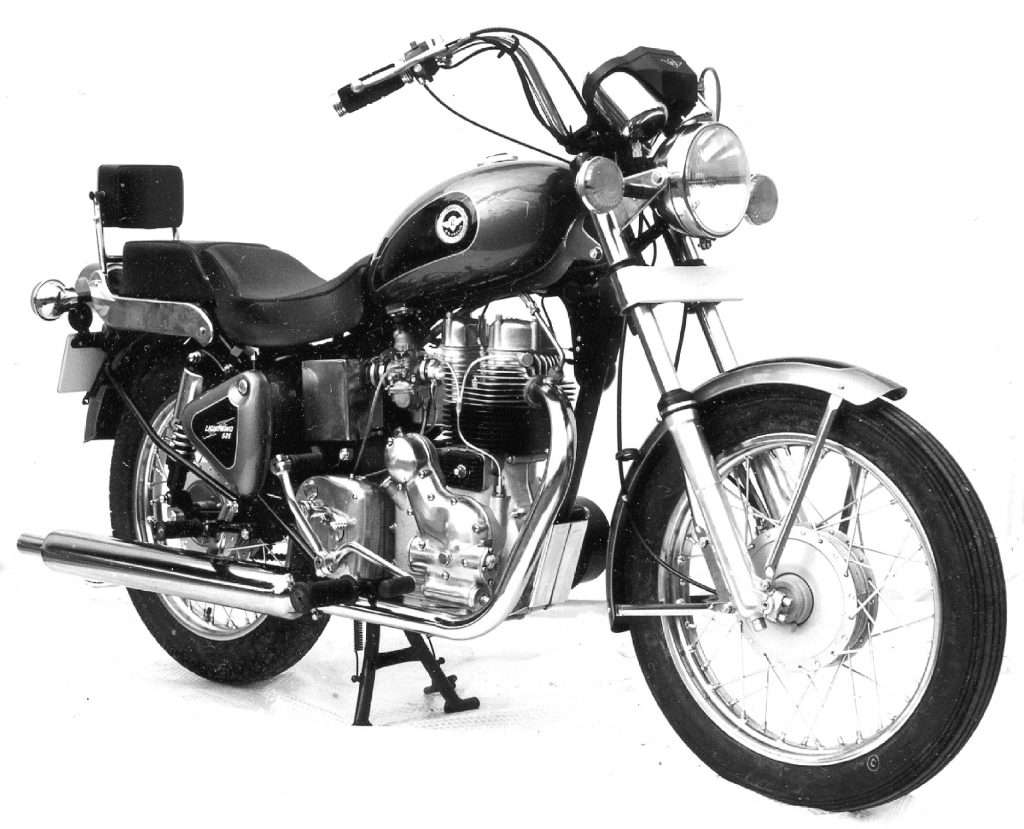
Even though the Lightning range had engines with 350, 500, and 535cc displacements, the Thunderbird came with just the 350cc mill. Featuring the feet-forward riding position and classic cruiser proportions, the Thunderbird range could be called one of the first notable mid-size cruisers India has had. The Thunderbird range got its much-deserved recognition among the people as and when the long-distance motorcycling culture started evolving here, courtesy to its touring-friendly ergonomics and the healthy powerhouse. The RE Thunderbird got a major makeover in 2005 wherein an interesting dual-tone paint scheme and a more comfortable set of gas-filled rear shocks were introduced.
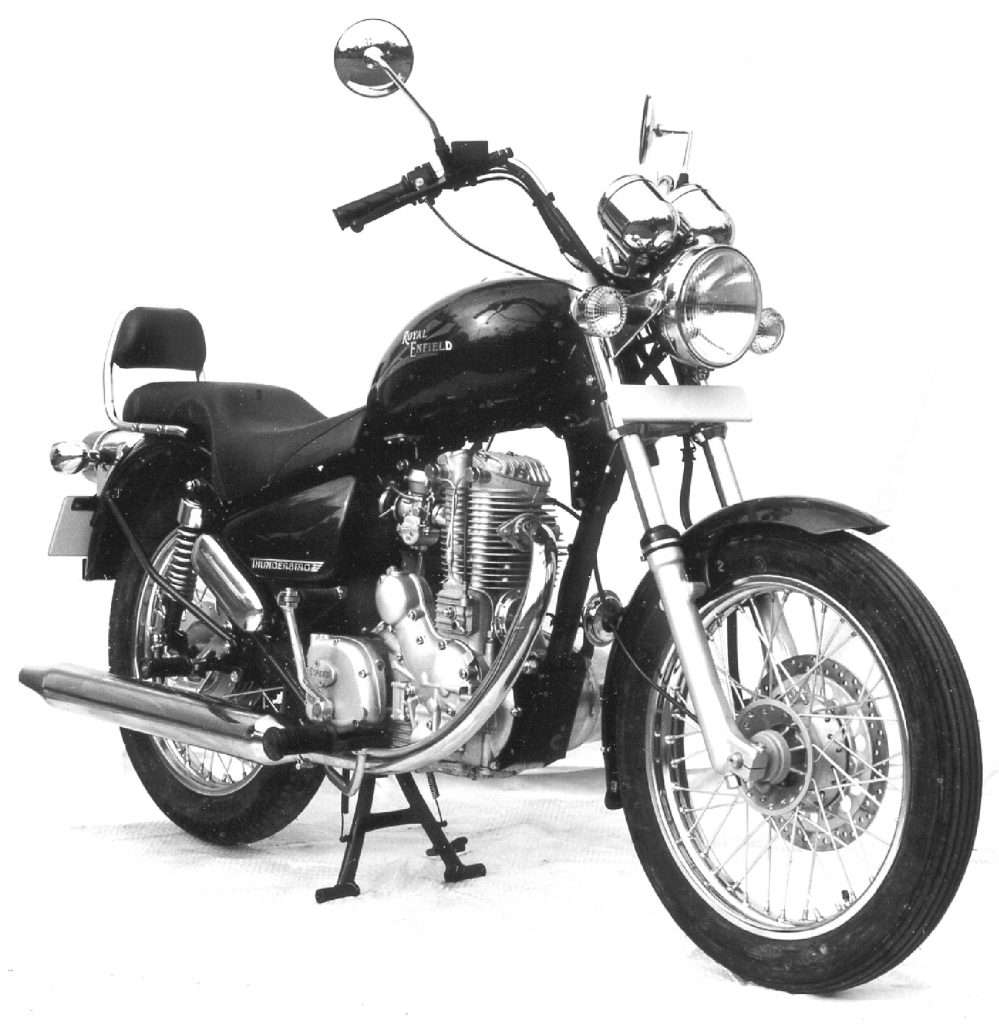
In 2008, a new, much more refined UCE (unit Construction Engine) replaced the traditional pushrod unit of the TB range, with the displacement remaining unchanged. It was in 2012 that the Thunderbird range got a much more powerful 500 cc engine from RE. The bike had also gotten a bigger tank that could house 20 litres of fuel, 18-inch wheels etc back then. Royal Enfield chose to show the TB range the end of its road with the Thunderbird X, something which they chose to call an ‘urban cruiser’ (Let’s not talk Toyotas here !) The Meteor 350 comes in as a worthy successor to the Thunderbird range.
What’s In A Name?!
While most of you might find the Meteor nomenclature absolutely new, it isn’t any for Royal Enfield. The bike manufacturer had had a motorcycle with the same name in the 1950s. Launched in 1952, to be precise, the Royal Meteor was quite famous for its touring abilities. It was also a motorcycle that stood the test of time. Thus carrying over the legendary nameplate would apparently hint at similar if not better capabilities for the new bike.
Quite A Bunch To Choose From !
Yes, the RE Meteor 350 has a bunch of variants, erm, not really, let’s call them editions, to choose from, viz – Fireball, Stellar, Supernova. While the Fireball looks too much like the Thunderbird X, the Supernova has distant resemblances to some of the elite full-size cruisers of the day. The Stellar stands somewhere in between these two. Our test piece was, to our delight, the Supernova!
Design
The overall design does fair justice to the Thunderbird series but looked more retro to my eyes. The bike has a majestic stance, with the front end being evidently taller than the rear, a stylish pear-shaped tank that, unlike the TB, can house just 15 liters, a circular headlamp that gets a conventional halogen setup, a rounded tail lamp that adds further to the bike’s retro air, and a handsome looking pillion backrest. At 765mm, the rider sits quite low, and on a well-designed seat.
I felt the pillion seat to be much like the one on the Thunderbird X. The ground clearance, however, has gone up by 35mm, to a handsome 170 millimeters. The overall weight of the bike has come down by 6 kilos, to a net 191 kg. This could be due to the cut in fuel tank capacity and the slightly lighter engine.
The Supernova comes with a lot of chrome embellishments and even a useful fly screen to further add to its elegance. The overall paint finish and material quality are excellent. However, there are a few niggles like the chromed fiber on the fuel cap which strike stark contrasts to the overall quality standards.
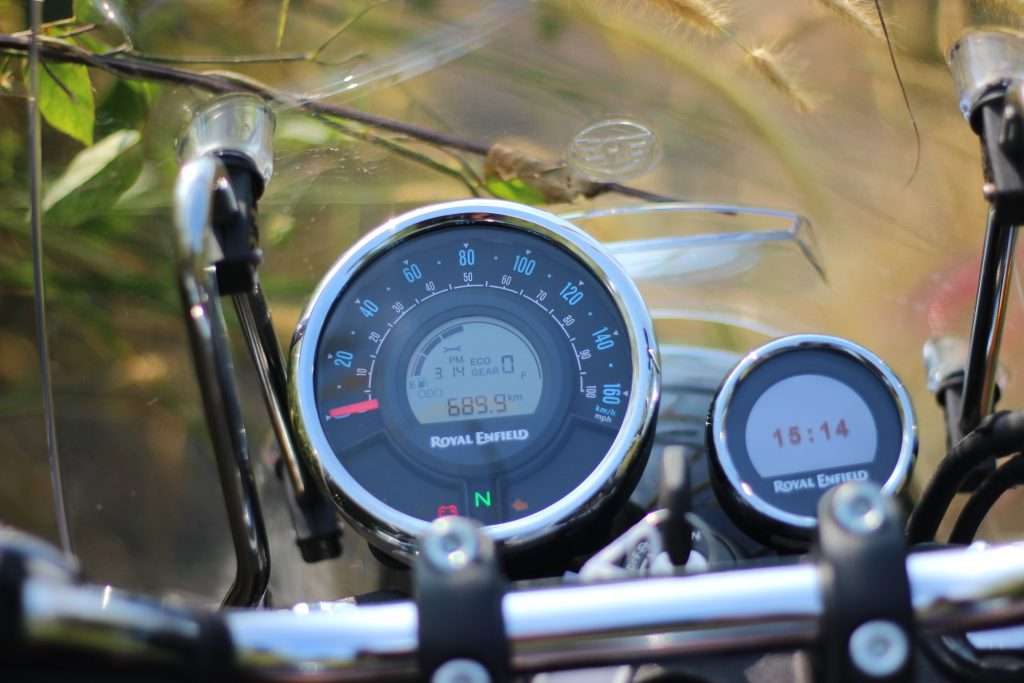
Equipment And Switchgear
The handlebar controls and switchgear reflect pronounced material and build qualities. There is no confusing clutter of switches or controls on the Meteor 350. Everything is wisely organized and neatly set up. The Engine start/kill switches have both been integrated into a single rotary unit, and so have been those for the headlamp and the ‘pass’. What replaced the conventional pass lamp button is the one to control the tiny MID screen on the console. This shuffle in switch positions would take some time to get used to.
The meter cluster is neat, readable and wisely lit. The cluster has a white backlight which did prove to be a bit too bright at times, especially during our night rides with the bike. The tiny rider information screen has all the essentials like a fuel gauge (which did confuse me at times with some random fluctuations), gear position indication, odo, trip etc. There is, however, no average fuel economy display or DTE (just saying …)
What sits next to the speedo cylinder is the key talking point of the equipment array here. Essentially an LED display, it is part of what Royal Enfield calls the RE Tipper, and which I would like to call, a smart Turn-By-Turn navigation unit. This system lets the bike connect to your smartphone, in which you’ll have to install the Royal Enfield App for the same. All you have to do to navigate is to type in the destination in the RE mobile app, and click ‘RIDE’. Google Maps would take things further ahead and display turn-by-turn navigation instructions on the bike’s display. I personally found this system very effective. The Meteor 350 is the first RE motorcycle to feature this tech.
Taking the rider demands into consideration, Royal Enfield has also given a USB charging port on the bike, which the designer did not find quite appealing and thus kept hidden to the left side of the bar! However, this is quite slow-paced in getting your phones charged.
Specifications
The cream of the Meteor 350 is its all-new engine. The bike gets a 349cc, air-oil cooled, 2-valve, single-cylinder engine that puts out a healthy 20.2 hp and 27 Nm. It definitely has shorter strokes than that of the TB, but is still a long-stroke unit by industry standards, measuring 72*85.8 mm. This mill gets a counter balance shaft in it, which renders unmatched refinement levels to it.
The transmission on offer is a 5-speed box. I would have liked a 6-speed unit better, but it turns out RE and I were not on the same page here! The bike also gets a 7-plate wet clutch which simplifies the game to a great extent in tight traffic manoeuvres.
Another key improvement on this bike is its chassis. The Meteor 350 has been co-developed by Royal Enfield’s R&D teams in Chennai and UK. Let’s put more light on it. You and I were wonderstruck when RE launched the Interceptor 650 and GT650 twins. Both the bikes had refinement and dynamics levels that were never seen on an RE before! This was because those bikes were developed by the manufacturer’s UK-based performance wing, Harris Performance. Harris Performance is a company that has exceptional expertise in building rally and motocross motorcycles. The Meteor 350 too gets a twin downtube spline frame designed by these guys, hinting at Interceptor levels of dynamics and handling, if not better, taking into consideration its sleeker proportions.

Performance
What is it like to ride the Meteor 350? Well, let us start with the vigor to get off the line. The Meteor 350 is definitely no enthu-cutlet, but is reasonably quick in getting off the line. 0-100 comes in around 17 seconds. The vehicle has a decent grunt in the low end, and a strong surge of torque in the mid-range. The high revs are quite flat though. Oh, and there is no tacho on this bike, to be any more precise on the RPMs! The Peak power comes at 6100rpm, which is much higher than the TB figures. The gearbox is slick but hardly precise. I ended up in false neutrals quite a number of times, trying to slot into the second gear, from the first.
Speeding on the highway would be no difficult chore for the Meteor. I could do speeds of upto 110kmph effortlessly. The fifth gear also has an overdrive function which further eases up things at higher speeds. The Fly screen definitely adds to the comfort and stability at high speed. A few vibes do seep in post 100kmph but are never big enough to throw you off the seat. 60-85 kmph, is what I felt, is the sweetest cruising range of this bike.
Braking is handled by 300mm disks at the front and 270mm units at the rear. These brakes have impressive stopping power but could have had better bites. A dual-channel ABS further adds to the rider confidence.
NOT AN RE By Refinement Levels!
The refinement is what makes this motorcycle stand out of the crowd. The Meteor feels as refined as the Interceptor 650. The NVH levels of this bike are absolutely fab! There are minimal vibrations felt at idling and lower revs, at the handlebar, footpegs, and the seat. Spinning the engine to higher numbers does yield a few vibes, especially at the footpegs and the bar, but are nothing by the usual RE standards.
The engine, however, retains the classical Royal Enfield thump. However, the thumping note has become a lot more refined and subtle on the Meteor 350.
Ride And Handling
The rider triangle on the Meteor 350 remains that of a thoroughbred cruiser. You sit relaxed with your feet forward and gripping the wide handlebar. However, the chassis of this bike has been designed in such a way that it feels like a cruiser on the highway but handles like a roadster in the cities. The dual cradle frame allows for quick, precise direction changes in the cities, for rock-solid rides on the highways, and faster slams into corners. The ride quality over broken patches is pretty impressive too. The Meteor gets 41mm forks at the front that offer a good 130mm travel and twin-tube emulsion shocks at the rear.
Fuel Efficiency
I did not perform a fuel efficiency test as such but from the odd 500-odd kilometres done, I would say the bike is definitely touring-friendly and the least of a glutton.
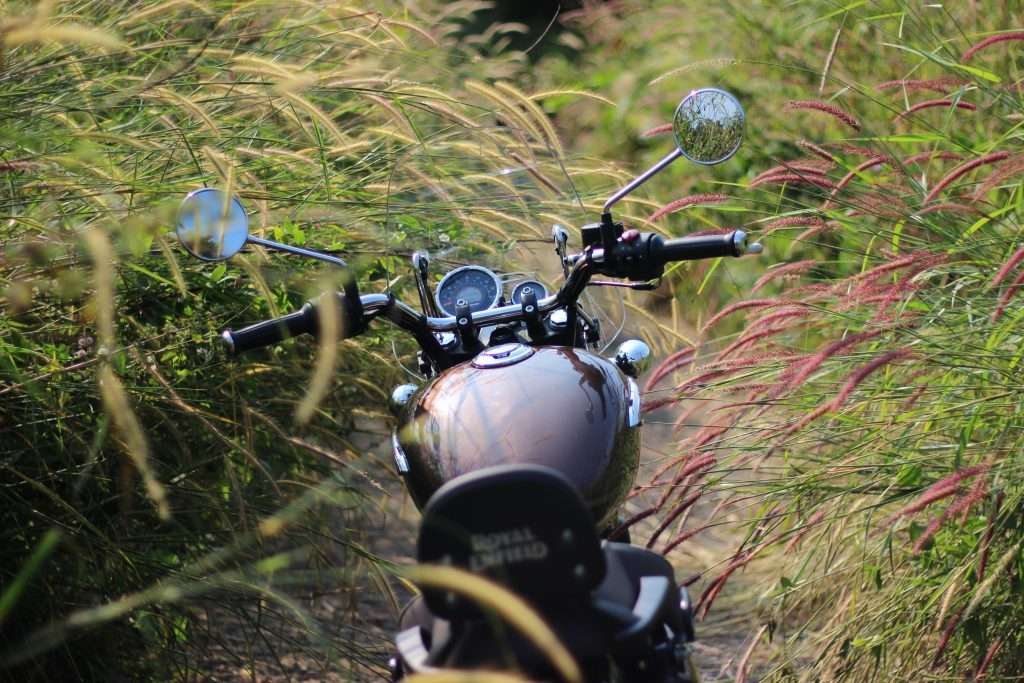
Meteor 350 Price And Variants
- Meteor Fireball- 1.75 lakh
- Meteor Stellar – 1.81 lakh
- Meteor Supernova- 1.95 lakh
What Could Have Been Improved?
- The headlamps could have had better throw and beam intensity. A set of projector beam headlamps like the ones on the TB would have solved the issue.
- A tachometer would have been much appreciated.
- Greater precision for the fuel gauge.
- The instrument cluster could have been less reflective.
Should You Buy One?
The Meteor locks horns with the likes of Honda Hness CB350 and the Jawa. Though it would be too out-of-place to come up with a comparative analysis in this article, I would definitely say the Meteor is now a worthy competitor for all the competition, if not better than some. Buy this if you are looking for a thoroughbred mid-size cruiser that can be used on a daily basis inside the city hustle as well, a bike that could do a fair bit of touring and still be a great city commuter…
ALSO READ:
- Putting 300+ Odd Kilometers On The Odo Of The First Level 1 Autonomous SUV In Its Segment: MG Gloster Review
- MG Hector Plus Review: Chauffeur Me Around Please…
- Kia Sonet Review: The Next Level Of Wild Tamed!

